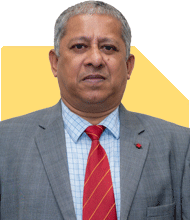Hello Vivek,
Hope you are doing well...!
I am 43 years of age living with my parents (Father aged 77 and Mother 73), working spouse (aged 42) and 13 years daughter. We are planning to retire by 50. Please have a look at below -
Our current investment corpus value is 1.10 CR which includes EPF, PPF, LIC, MF, Shares, Jewellery.
We are expecting this to grow up to 2.50 CR by the end of March 2032, with regular investments, power of compounding and NIL withdrawals.
We both are insured with Mediclaim and Term insurance. Parents are covered with Mediclaim which my employer has provided.
Our current monthly expenses are 1.20 lacs per month.
Currently we have invested around 13 lacs in MF for daughter's future (the same are over and above 1.10 CR)
Kindly advise us if we both can retire in 2032 with a corpus of 2.50 CR which we can use for next 30 years considering life expectancy of 80 years.
Warm Regards,
Vishwas Joshi
Ans: You have done excellent in building a Rs 1.10?crore corpus by age 43. Your planning for retirement at 50 is disciplined and thoughtful. Now, let us craft a detailed 360?degree plan to assess whether Rs?2.50?crore by March 2032 (age 50) can support your family for 30 years (until age 80).
Appreciating Your Current Strengths
You have a total corpus of Rs?1.10?crore including EPF, PPF, LIC, MFs, shares, jewellery.
You anticipate growing it to Rs?2.50?crore in 9 years with new investments and compounding.
You both have term and health insurance cover already.
Monthly household expenses (excluding parents) are Rs?1.20?lacs.
You've invested Rs?13?lacs more for your daughter’s future; that is wisely kept separate.
These are strong foundations. You are taking life planning seriously. A well-structured approach ahead will help ensure your retirement goals stay on track.
Understanding Your Goal and Assumptions
You plan to retire at age 50 (in March 2032). You expect to use the Rs?2.50?crore corpus for the next 30 years. That covers family needs until age 80.
Let us confirm key variables:
Monthly expenses today: Rs?1.20?lacs (household of four).
Inflation of expenses (assume 6% annually) until 2032.
Corpus size at retirement: Rs?2.50?crore.
Post?retirement duration: 30 years.
Income sources after 50: whether pensions or only withdrawals? (Assume no pension for now.)
Estimating Post?Retirement Cash Flow Needs
Currently, 10 years out, you spend Rs?1.20?lacs a month. Inflation at 6% will nearly double this by 2032. So:
Monthly expenses in 2032 could be around Rs?2.20?–?2.25?lacs.
Annual expenses → around Rs?26?–?27?lacs.
For 30 years, inflation will continue. Yearly costs could expand to Rs?26?lacs growing annually.
A Rs?2.50?crore corpus would need to provide rising income to meet this increasing cost.
Can Rs?2.50?crore Corpus Sustain You for 30 Years?
To answer, we must test sustainability with a realistic withdrawal plan:
You need Rs?26?lacs in Year?1 of retirement.
You will need more each year to match inflation.
The corpus must earn sufficient returns to cover rising withdrawals and not be exhausted in 30 years.
A pure equity-heavy portfolio may generate high returns but also high volatility. Unstable income years may disrupt withdrawal plans.
A purely debt-heavy portfolio won't provide enough growth to meet rising expenses.
A balanced but dynamic investment strategy is required. It must aim for real growth (above inflation) while controlling downside risk.
Building a Post?Retirement Portfolio Strategy
We need to prepare for a corpus that both grows and generates stable withdrawals. Here is a suitable asset mix:
1. Equity Mutual Funds (40–50%)
Actively managed large?cap, multi?cap, and select mid?cap equity funds
Helps fight inflation, grow corpus over long term
2. Debt Mutual Funds (30–40%)
Medium?term, credit?oriented income funds, short?duration funds
Provides stability, regular accruals, income stream
3. Income or Dynamic Bond Funds (10–15%)
Offers regular interest payouts
Useful for monthly income requirements
4. Liquid or Ultra?Short Funds (5–10%)
For emergency liquidity and near?term spending
5. Gold or Commodity Funds (5–10%)
Helps hedge against inflation when money value erodes
Structuring Withdrawal Post?Retirement
To stretch Rs?2.50?crore for 30 years, a Systematic Withdrawal Plan (SWP) is essential:
Withdraw total amount needed each month/year via SWP
Align SWP rates with expected portfolio returns and inflation
Rebalance the portfolio annually to maintain allocation
Adjust SWP downwards if market downturn reduces corpus significantly
This strategy ensures income remains aligned with needs and portfolio remains resilient.
Reviewing Pre?Retirement Investment Plan
You plan to grow Rs?1.10?crore to Rs?2.50?crore in 9 years. Let’s evaluate feasibility:
Your top?up corpus: Rs?1.40?crore over 9 years (approx Rs?15?–?16?lacs per year)
That needs annual investment contributions via SIP/lump sum + fund growth
With good active equity returns and disciplined contributions, this is feasible
But in current plan:
Your corpus includes illiquid assets like LIC, jewellery — these may opt out of growth traction
Actively managed equity funds needed to pursue growth
Investing in online direct plans without guidance may reduce discipline and portfolio review
Impact of Insurance, Tax, and Emergency Funds
You’ve already arranged insurance. Great.
Focus now on:
Emergency fund: 6–12 months of expenses parked in liquid funds
This ensures no forced withdrawals from investment corpus
Tax planning: Equity fund redemptions post?retirement can be structured to remain in LTCG limit to avoid 12.5% tax
Debt fund gains taxed per slab—plan withdrawals wisely
By combining insurance, taxation awareness, and emergency liquidity, you create a safe structural backdrop.
Importance of Active Fund Management
You said your current corpus includes MFs and shares. If in direct mutual funds, be aware:
Direct plans lack periodic reviews or rebalancing
Market cycles may swing portfolio value
You need fund selection and regular monitoring
Hence, switch to regular mutual funds via a Certified Financial Planner?backed MFD:
Access to portfolio reviews and rebalancing
Guiding on contribution increases over time
Drift correction (e.g. equity ratio too high)
Behavioural help during market corrections
This guidance helps the Rs?2.50?crore target remain achievable and safe.
Steps to Strengthen Your Plan Today
Set up Emergency Liquidity: Rs 7–10 lacs in liquid/ultra?short funds
Switch to Regular Plans: Convert direct funds via CFP?MFD
Boost Equity SIPs: Raise monthly investments gradually
Add Lump Sums: Use bonuses/extra income to top?up
Plan Allocation Shifts Now: Begin building equity, debt, gold mix
Monitor via CFP Review: Quarterly or semi?annual portfolio reviews
Plan Pre?Retirement Withdrawals: Align SWP setup by 2032
Protect Parents’ Future: Last?mile medical needs ~ 5–10 years
These steps build discipline and protect your goal journey.
What to Do Between Now and March 2032
Years 1–3: Build liquidity; grow contributions; set up SWP framework
Years 4–7: Increase contributions; maintain allocation; mid?plan review
Years 8–9: Reduce equity exposure to 40–50%; shift to safer debt/liquid
Retirement Year (2032): Corpus ready; asset mix aligned; SWP live
Your total outflow will match rising expenses and continue to grow your pension corpus.
Behavioral and Emotional Aspects
Don’t withdraw monthly before 2032 except emergency
Avoid impulsive portfolio changes based on market noise
Keep your family informed on plan updates
Encourage your spouse’s involvement in decisions
Disciplined patience today helps generate smoother withdrawals tomorrow.
Tax Savings During Accumulation and Withdrawal
While accumulating, invest in tax?efficient funds for growth.
While withdrawing post?2032, plan:
Equity fund redemptions limited to LTCG threshold
Keep tax liability minimal by spreading redemptions
Use debt fund redemptions aligned with lower tax slab
This maintains your net corpus for living expenses.
Retirement Risk Triggers to Watch
Inflation: Can erode purchasing power.
Ensure your portfolio’s equity share is enough to combat inflation
Longevity risk: You may live beyond 80
Consider planning for at least 35–40 years
Healthcare risk: Medical inflation accelerates with age
Keep a separate long-term health buffer
Market volatility: Major downturns near retirement (2030) can dent corpus
Maintain conservative asset allocation close to retirement
Regular Plan Through CFP?Led MFD: Why It Matters
Focus areas under ongoing partnership:
Annual goal progress tracking
Fund switches when underperforming
Strategic portfolio rebalancing
Adjusting contributions with life events
Income flow testing before retirement
And crucial behavioural support
These actions safeguard your plan from execution errors.
Final Insights
Achieving Rs?2.50?crore corpus is possible with disciplined saving
Growing the corpus must align with risk, goal, taxes, inflation, and longevity
Active portfolio monitoring via CFP?MFD fosters better outcomes than direct plans
A well?balanced portfolio combined with SWP can provide inflation?adjusted income for 30+ years
Emergency fund, insurance coverage, tax strategy, and regular reviews make your retirement plan robust
You have set a clear retirement date and corpus goal. With active management and disciplined investing, you are well-positioned to achieve it. If you need step?by?step plan execution or allocation suggestions, I can help you build and track this plan effectively.
Best Regards,
K. Ramalingam, MBA, CFP,
Chief Financial Planner,
www.holisticinvestment.in
https://www.youtube.com/@HolisticInvestment






















